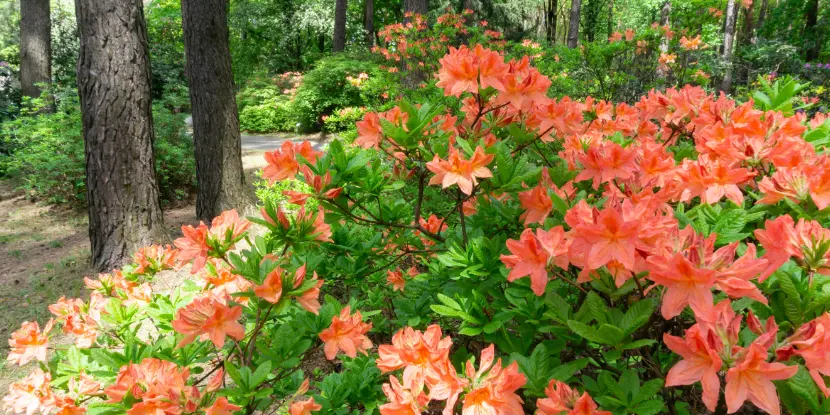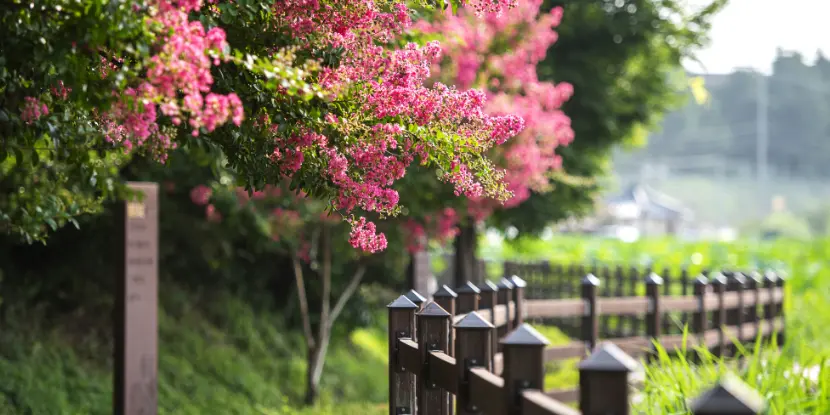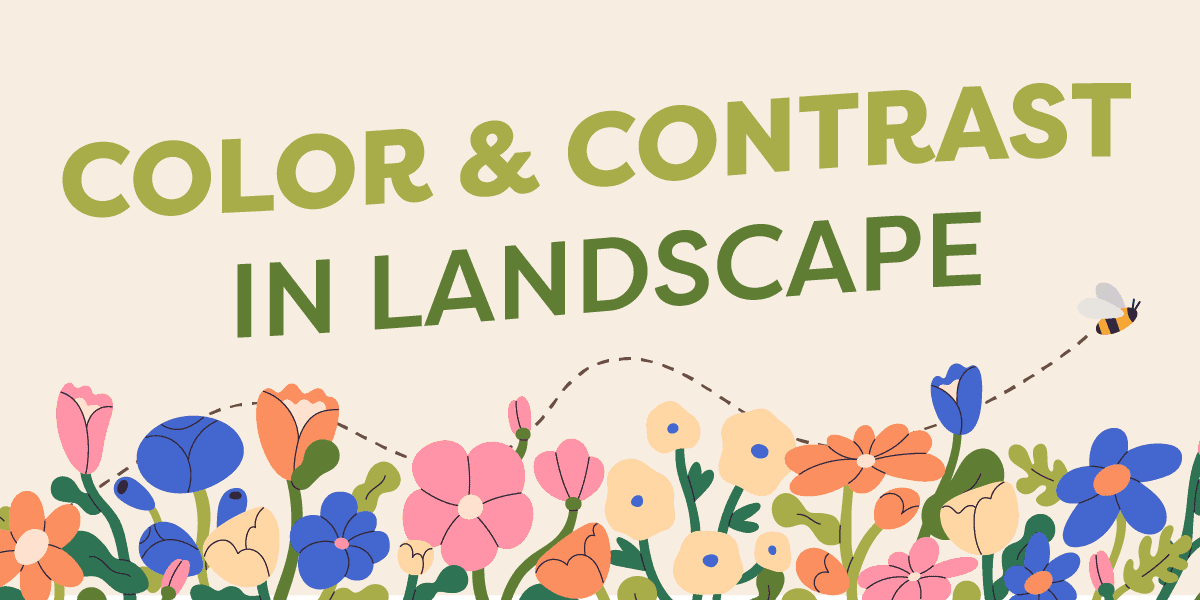Shrubs and trees can provide a rainbow of colors in the landscape. Their longevity matters because of the cost to establish and maintain them.
Shrubs & Flowers
The spring-flowering shrubs with color are:
- azalea – pink, purple, red or white
- flowering quince – orange, pink, red, or white
- forsythia – yellow
- hypericum – yellow
- Indian hawthorn – pink or white
- mountain laurel – purple
- snowball – white
- weigela – pink, red, or white

An azalea shrub in bloom.
The spring and summer flowering shrubs with color are:
- althaea – pink, red, violet or white
- bridal wreath – purple or white
- gardenia – white
- hydrangea – blue, pink, or white
- oleander – pink, red, white or yellow
- pomegranate – red
The summer flowering shrubs with color are:
- abelia – pink or white
- bottlebrush – red
The summer and fall flowering shrubs with color are:
- crape myrtle – pink, red, purple, or white
- flowery senna – golden yellow
- purple sage – lavender-pink or white
The late fall-to-spring flowering shrubs with color are:
- camellia – pink, red, or white
- Italian jasmine – yellow
- primrose jasmine – yellow

A Chinese pistache tree with autumn colors.
Shrubs with fruit
The shrubs with colorful fruit are:
- aucuba – red
- barberry – purple or red
- cotoneaster – red
- euonymus – red
- holly – red or yellow
- honeysuckle – red
- Indian hawthorn – purple
- juniper- steel blue
- ligustrum – blue-purple
- mahonia – steel blue
- nandina – orange-red
- photinia – red
- pomegranate – red
- pyracantha – orange, red, or yellow
- redwing – red
- rose – red
- viburnum – black or red

Potted flowers give your landscaping flexibility.
Longevity of Trees
The trees with a long life span (over 50 years) are bald cypress, bur oak, cedar elm, Chinese pistache, Chinquapin oak, crape myrtle, dogwood, Eastern red cedar, lacebark elm, live oak, Loblolly pine, magnolia, pecan, red oak, slash pine, sweetgum, water oak, and yaupon holly.
The trees with a medium life span (25 to 50 years) are Chinese tallow, cottonwood, crabapple, Deodar cedar, golden raintree, green ash, hackberry, loquat, ornamental pear, redbud, and silver maple.
The trees with a short life span (under 25 years) are Arizona ash, boxelder, catalpa, Chinaberry, fruitless mulberry, Lombardy popular, mimosa, Siberian elm, sycamore, and willow.
Trees & Flowers
These trees produce spring flowers with color:
- crabapple – pink, rose-red or white
- dogwood – pink, red, or white
- possumhaw holly – white & red berries
- flowering peach – pink, red, or white
- flowering pear – white
- flowering plum – pale pink or white
- redbud – burgundy, pink, or white
- saucer magnolia – white/orchid blend
- southern magnolia – white

This flowering pear tree will later bear fruit.
The summer flowering trees with color are:
- althaea (rose of Sharon) – lavender, pink or white
- crape myrtle – lavender, pink, red, or white
- golden raintree (northern) – yellow
- golden raintree (southern) – yellow
- mimosa (silktree) – pink
- pomegranate – orange-red
- retama (Jerusalem thorn) – yellow
Trees with red leaves
The best trees for red fall color are blackgum, Chinese pistache, Chinese tallow, crape myrtle, dogwood, Japanese maple, ornamental pear, red maple, red oak, smoke tree, sumac, and sweetgum.
Trees with yellow leaves
The best trees for yellow fall color are American elm, Arizona ash, ginkgo, green ash, persimmon, pomegranate, silver maple, and western soapberry.
Transplanting Trees & Shrubs
Transplanting shrubs or trees usually causes considerable damage to the root system. You should prune the limbs to an extent more than the damage to the root system, so the plant will continue to grow. If limbs aren’t pruned, the plant may die during the summer or not grow much for several years.
The hole should be slightly shallower than the roots so that the soil mark on the plant will be higher than ground level. Soil removed from the hole can backfill around the roots. Backfill the hole to about half, then cover the soil with water and wiggle the plant so the air around the roots bubbles up.
Backfill the remaining soil and form a small berm around the plant and over the hole’s edge. Apply more water to soak the topsoil. The plant may need more water each week during the first year.

A flowering crape myrtle tree.
Seasonal Maintenance
- Apply a layer of mulch to help retain moisture in the soil and suppress weeds.
- Fertilize shrubs in late winter or early spring before new growth begins.
- Prune flowering shrubs after they finish blooming, typically in late spring or summer.
- Keep an eye out for pests and diseases and treat them accordingly.
- Water trees and shrubs deeply once a week during periods of drought.
Tree & Shrub Selection for Southern California
- Consider drought-tolerant and native species for low maintenance.
- Choose trees and shrubs that will flourish in your specific climate and soil conditions.
- Look for disease-resistant varieties to reduce the need for chemical treatments.
- Research the mature size of a plant before purchasing to ensure it fits well in your landscape.
- Select plants with varying bloom times to add interest and color throughout the year.
Designing with Trees & Shrubs
- Use trees and shrubs to create shade, privacy, and visual interest in your landscape.
- Plant in groupings or clusters for a natural and cohesive look.
- Incorporate different textures and shapes to create depth.
- Consider the blooming season of plants when designing to create a continuous show of color.
Planting for Pollinators
- Choose plants that provide food and shelter for pollinators, such as bees, butterflies, and birds.
- Plant a variety of flowering trees and shrubs to attract different pollinator species.
- Avoid using pesticides on or near flowering plants.
FAQs: Landscape Color & Contrast
Q: How can I add more color to my landscape without planting new trees or shrubs?
You can incorporate colorful annuals and perennials into existing flowerbeds or containers. You can also use hardscaping, such as decorative stones or colorful mulch, to add contrast and interest to your landscape.
Q: Can I plant fruit-bearing shrubs in my landscape for color and food?
Many shrubs with colorful fruit also produce edible fruits, making them a great addition to any landscape.
Q: What are some trees that provide good shade and require minimal maintenance?
Trees like live oak, Chinese pistache, and cedar elm are excellent choices for shade and require minimal maintenance. They are also drought-tolerant, disease-resistant, and adaptable to various soil types.
Q: How can I improve soil quality before planting trees or shrubs?
Add organic matter such as compost or well-rotted manure. This helps enrich the soil, improves drainage, and promotes healthy root development. Conducting a soil test can also guide you in adjusting pH levels or nutrient content.
Q: What types of shrubs work well for adding privacy to a landscape?
Boxwood, holly, and arborvitae are popular for creating privacy hedges. They thrive when planted closely together and can be easily pruned to maintain your desired height and shape.
Q: How do I protect my young trees from extreme weather conditions?
Stake them to prevent wind damage and applying a thick layer of mulch around the base to regulate soil temperature. Use tree wraps to shield the trunk from freezing temperatures or intense sun.

